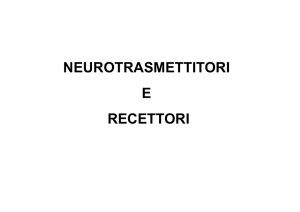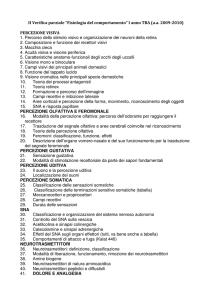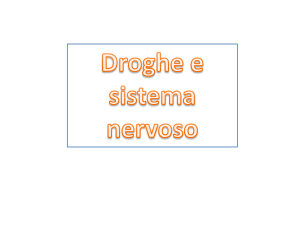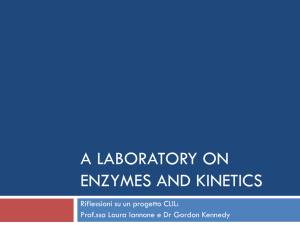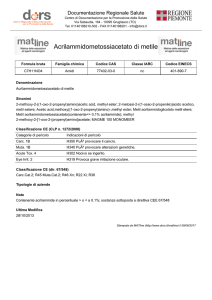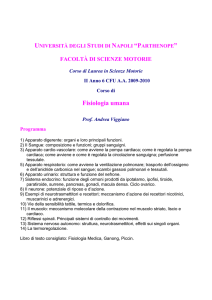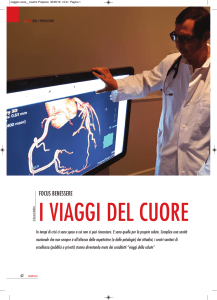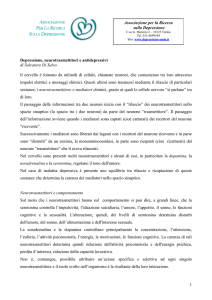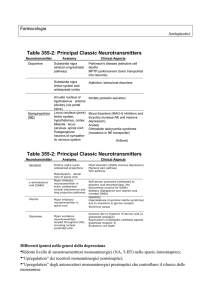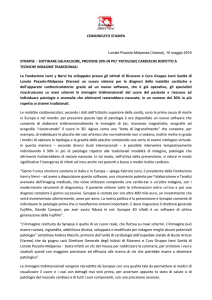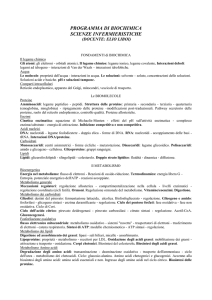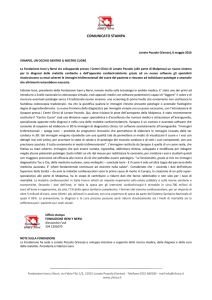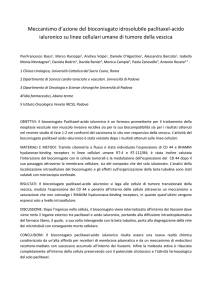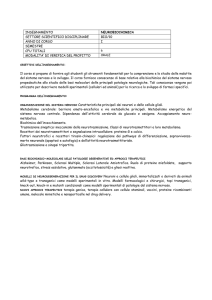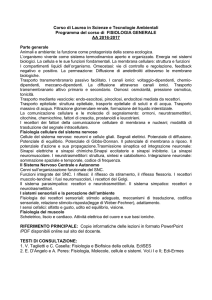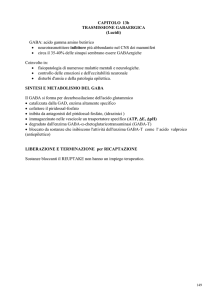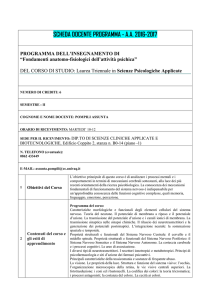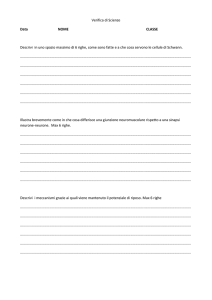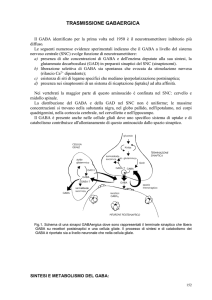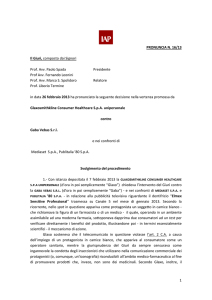Informatica Biomedica - Dipartimento di Informatica e Automazione
annuncio pubblicitario
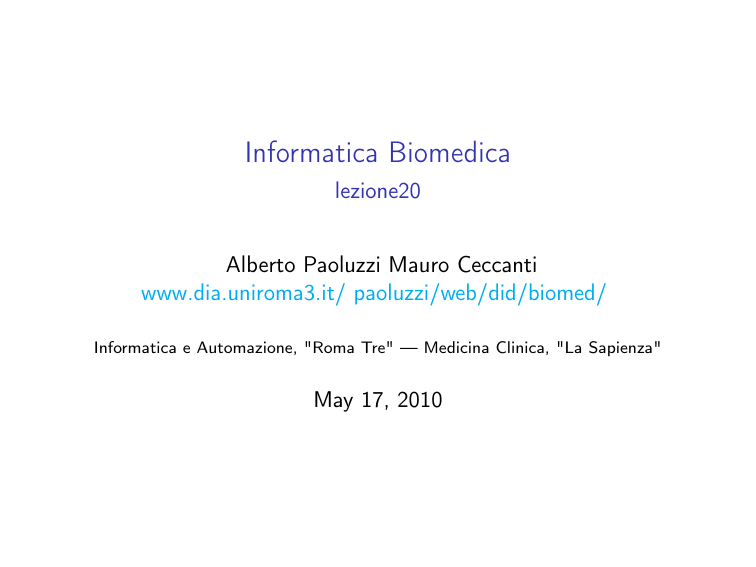
Informatica Biomedica lezione20 Alberto Paoluzzi Mauro Ceccanti www.dia.uniroma3.it/ paoluzzi/web/did/biomed/ Informatica e Automazione, "Roma Tre" — Medicina Clinica, "La Sapienza" May 17, 2010 Informatica Biomedica: Lezione 20 Neurotrasmettitori Definizione Classificazioni Neurotransmittitori principali Eccitatori e inibitori Esempi di neurotrasmettitori Sistemi neurotrasmettitori Peptides: neuropeptides Obiettivo Estratto dall’articolo Neurotrasmitters di Wikipedia. Si intende fornire delle linee guida rispetto alla costruzione di un repository locale, impiantato presso il DIA di Roma Tre, delle molecole biologiche con funzionalità di neurotrasmettitore. Contents Neurotrasmettitori Definizione Classificazioni Neurotransmittitori principali Eccitatori e inibitori Esempi di neurotrasmettitori Sistemi neurotrasmettitori Peptides: neuropeptides Definition Si chiamano neurotrasmettitori le sostanze chimiche che facilitano la comunicazione tra le cellule nervose (neuroni) Definition Si chiamano neurotrasmettitori le sostanze chimiche che facilitano la comunicazione tra le cellule nervose (neuroni) I Queste non si toccano tra loro, ma comunicano attraverso terminazioni dette sinapsi e la regione esterna detta intersinaptica Definition Si chiamano neurotrasmettitori le sostanze chimiche che facilitano la comunicazione tra le cellule nervose (neuroni) I Queste non si toccano tra loro, ma comunicano attraverso terminazioni dette sinapsi e la regione esterna detta intersinaptica I Quando un messaggio raggiunge una terminazione di un neurone, sviluppa il rilascio di sostanze chimiche neurotrasmettitrici nella sinapsi Definition Si chiamano neurotrasmettitori le sostanze chimiche che facilitano la comunicazione tra le cellule nervose (neuroni) I Queste non si toccano tra loro, ma comunicano attraverso terminazioni dette sinapsi e la regione esterna detta intersinaptica I Quando un messaggio raggiunge una terminazione di un neurone, sviluppa il rilascio di sostanze chimiche neurotrasmettitrici nella sinapsi I Queste attraverso la membrana sinaptica, viaggiano nello spazio intersinaptico, attraversano la membrana della sinapsi del prossimo neurone nella catena trasmissiva, e stimolano questo a trasmettere il messaggio lungo la catena di cellule nervose Definition Si chiamano neurotrasmettitori le sostanze chimiche che facilitano la comunicazione tra le cellule nervose (neuroni) I Queste non si toccano tra loro, ma comunicano attraverso terminazioni dette sinapsi e la regione esterna detta intersinaptica I Quando un messaggio raggiunge una terminazione di un neurone, sviluppa il rilascio di sostanze chimiche neurotrasmettitrici nella sinapsi I Queste attraverso la membrana sinaptica, viaggiano nello spazio intersinaptico, attraversano la membrana della sinapsi del prossimo neurone nella catena trasmissiva, e stimolano questo a trasmettere il messaggio lungo la catena di cellule nervose I I farmaci neuroattivi agiscono al livello dei neurotrasmettitori Definition Si chiamano neurotrasmettitori le sostanze chimiche che facilitano la comunicazione tra le cellule nervose (neuroni) I Queste non si toccano tra loro, ma comunicano attraverso terminazioni dette sinapsi e la regione esterna detta intersinaptica I Quando un messaggio raggiunge una terminazione di un neurone, sviluppa il rilascio di sostanze chimiche neurotrasmettitrici nella sinapsi I Queste attraverso la membrana sinaptica, viaggiano nello spazio intersinaptico, attraversano la membrana della sinapsi del prossimo neurone nella catena trasmissiva, e stimolano questo a trasmettere il messaggio lungo la catena di cellule nervose I I farmaci neuroattivi agiscono al livello dei neurotrasmettitori I La presenza nel cervello di uno specifico farmaco cambia la quantità dei neurotramettitori disponibili per la trasmissione dei segnali di vario tipo. Neurotransmitter containers Neurotransmitters are packaged into synaptic vesicles that cluster beneath the membrane on the presynaptic side of a synapse, and are released into the synaptic cleft, where they bind to receptors in the membrane on the postsynaptic side of the synapse Neurotransmitter containers Neurotransmitters are packaged into synaptic vesicles that cluster beneath the membrane on the presynaptic side of a synapse, and are released into the synaptic cleft, where they bind to receptors in the membrane on the postsynaptic side of the synapse I Release of neurotransmitters usually follows arrival of an action potential at the synapse, but may follow graded electrical potentials Neurotransmitter containers Neurotransmitters are packaged into synaptic vesicles that cluster beneath the membrane on the presynaptic side of a synapse, and are released into the synaptic cleft, where they bind to receptors in the membrane on the postsynaptic side of the synapse I Release of neurotransmitters usually follows arrival of an action potential at the synapse, but may follow graded electrical potentials I Low level "baseline" release also occurs without electrical stimulation. Generalities Ci sono differenti modi di classificare i neurotramettitori Generalities Ci sono differenti modi di classificare i neurotramettitori I dividerli in aminoacidi, peptidi e monoamine è sufficiente per alcuni scopi Generalities Ci sono differenti modi di classificare i neurotramettitori I dividerli in aminoacidi, peptidi e monoamine è sufficiente per alcuni scopi I Possono anche essere classificati in eccitatori e inibitori, sebbene spesso entrambe le funzioni possano essere svolte in funzione del contesto. UW FMA Classification http://sig.biostr.washington.edu/projects/fm/ UW FMA Explorer Amino acid neurotransmitter (1/2) glutamate, aspartate, serine, γ-aminobutyric acid (GABA), glycine An amino acid neurotransmitter is a chemical substance which is able to transmit a nerve message across a synapse Amino acid neurotransmitter (1/2) glutamate, aspartate, serine, γ-aminobutyric acid (GABA), glycine An amino acid neurotransmitter is a chemical substance which is able to transmit a nerve message across a synapse I Neurotransmitters (chemicals) are packaged into vesicles that cluster beneath the axon terminal membrane on the presynaptic side of a synapse in a process called endocytosis Amino acid neurotransmitter (1/2) glutamate, aspartate, serine, γ-aminobutyric acid (GABA), glycine An amino acid neurotransmitter is a chemical substance which is able to transmit a nerve message across a synapse I Neurotransmitters (chemicals) are packaged into vesicles that cluster beneath the axon terminal membrane on the presynaptic side of a synapse in a process called endocytosis I Amino acid neurotransmitter release (exocytosis) is dependent upon calcium ions (Ca+ 2 )andisapresynapticresponse Amino acid neurotransmitter (1/2) Amino acid neurotransmitter (1/2) I There are inhibitory amino acids (IAA) or excitatory amino acids (EAA) Some EAA L-Glutamate, L-Aspartate, L-Cysteine, and L-Homocysteine Amino acid neurotransmitter (1/2) I There are inhibitory amino acids (IAA) or excitatory amino acids (EAA) Some EAA L-Glutamate, L-Aspartate, L-Cysteine, and L-Homocysteine Amino acid neurotransmitter (1/2) I There are inhibitory amino acids (IAA) or excitatory amino acids (EAA) Some EAA L-Glutamate, L-Aspartate, L-Cysteine, and L-Homocysteine 1. These neurotransmitter systems will activate post-synaptic cells Some IAA γ-aminobutyric acid (GABA), Glycine, β-Alanine, and Taurine Amino acid neurotransmitter (1/2) I There are inhibitory amino acids (IAA) or excitatory amino acids (EAA) Some EAA L-Glutamate, L-Aspartate, L-Cysteine, and L-Homocysteine 1. These neurotransmitter systems will activate post-synaptic cells Some IAA γ-aminobutyric acid (GABA), Glycine, β-Alanine, and Taurine Amino acid neurotransmitter (1/2) I There are inhibitory amino acids (IAA) or excitatory amino acids (EAA) Some EAA L-Glutamate, L-Aspartate, L-Cysteine, and L-Homocysteine 1. These neurotransmitter systems will activate post-synaptic cells Some IAA γ-aminobutyric acid (GABA), Glycine, β-Alanine, and Taurine 1. The IAA depress the activity of post-synaptic cells Monoamine neurotransmitters: Monoamine neurotransmitters are neurotransmitters and neuromodulators that contain one amino group that is connected to an aromatic ring by a two-carbon chain (−CH2 − CH2 −). All monoamines are derived from aromatic amino acids like phenylalanine, tyrosine, tryptophan, and the thyroid hormones by the action of aromatic amino acid decarboxylase enzymes. They include: dopamine (DA), norepinephrine (noradrenaline; NE, NA), epinephrine (adrenaline), histamine, serotonin (SE, 5-HT), melatonin Peptides: over 50 neuroactive peptides have been found (trovarli tutti), and new ones are discovered regularly Peptides: over 50 neuroactive peptides have been found (trovarli tutti), and new ones are discovered regularly I Many of these are "co-released" along with a small-molecule transmitter, but in some cases a peptide is the primary transmitter at a synapse. See Peptide Neurotransmitters estracted from book Neuroscience, Fourth Edition Others: acetylcholine (ACh), adenosine, anandamide, nitric oxide, etc. single ions: such as synaptically released zinc, are also considered neurotransmitters by some, as are some gaseous molecules such as nitric oxide (NO) and carbon monoxide (CO) single ions: such as synaptically released zinc, are also considered neurotransmitters by some, as are some gaseous molecules such as nitric oxide (NO) and carbon monoxide (CO) I These are not classical neurotransmitters by the strictest definition, however, because although they have all been shown experimentally to be released by presynaptic terminals in an activity-dependent way, they are not packaged into vesicles Il solo effetto diretto di un neurotrasmettitore è di attivare uno o più tipi di recettori Il solo effetto diretto di un neurotrasmettitore è di attivare uno o più tipi di recettori I The effect on the postsynaptic cell depends, therefore, entirely on the properties of those receptors. It happens that for some neurotransmitters (for example, glutamate), the most important receptors all have excitatory effects: that is, they increase the probability that the target cell will fire an action potential. Il solo effetto diretto di un neurotrasmettitore è di attivare uno o più tipi di recettori I The effect on the postsynaptic cell depends, therefore, entirely on the properties of those receptors. It happens that for some neurotransmitters (for example, glutamate), the most important receptors all have excitatory effects: that is, they increase the probability that the target cell will fire an action potential. I For other neurotransmitters (such as GABA), the most important receptors all have inhibitory effects. Il solo effetto diretto di un neurotrasmettitore è di attivare uno o più tipi di recettori I The effect on the postsynaptic cell depends, therefore, entirely on the properties of those receptors. It happens that for some neurotransmitters (for example, glutamate), the most important receptors all have excitatory effects: that is, they increase the probability that the target cell will fire an action potential. I For other neurotransmitters (such as GABA), the most important receptors all have inhibitory effects. I There are, however, other neurotransmitters, such as acetylcholine, for which both excitatory and inhibitory receptors exist; Il solo effetto diretto di un neurotrasmettitore è di attivare uno o più tipi di recettori I The effect on the postsynaptic cell depends, therefore, entirely on the properties of those receptors. It happens that for some neurotransmitters (for example, glutamate), the most important receptors all have excitatory effects: that is, they increase the probability that the target cell will fire an action potential. I For other neurotransmitters (such as GABA), the most important receptors all have inhibitory effects. I There are, however, other neurotransmitters, such as acetylcholine, for which both excitatory and inhibitory receptors exist; I and there are some types of receptors that activate complex metabolic pathways in the postsynaptic cell to produce effects that cannot appropriately be called either excitatory or inhibitory. Glutamate is used at the great majority of fast excitatory synapses in the brain and spinal cord Glutamate is used at the great majority of fast excitatory synapses in the brain and spinal cord I It is also used at most synapses that are "modifiable", i.e Glutamate is used at the great majority of fast excitatory synapses in the brain and spinal cord I It is also used at most synapses that are "modifiable", i.e I capable of increasing or decreasing in strength Glutamate is used at the great majority of fast excitatory synapses in the brain and spinal cord I It is also used at most synapses that are "modifiable", i.e I capable of increasing or decreasing in strength I Modifiable synapses are thought to be the main memory-storage elements in the brain. GABA is used at the great majority of fast inhibitory synapses in virtually every part of the brain GABA is used at the great majority of fast inhibitory synapses in virtually every part of the brain I Many sedative/tranquilizing drugs act by enhancing the effects of GABA GABA is used at the great majority of fast inhibitory synapses in virtually every part of the brain I Many sedative/tranquilizing drugs act by enhancing the effects of GABA I Correspondingly glycine is the inhibitory transmitter in the spinal cord. Acetylcholine is distinguished as the transmitter at the neuromuscular junction connecting motor nerves to muscles Acetylcholine is distinguished as the transmitter at the neuromuscular junction connecting motor nerves to muscles I The paralytic arrow-poison curare acts by blocking transmission at these synapses Acetylcholine is distinguished as the transmitter at the neuromuscular junction connecting motor nerves to muscles I The paralytic arrow-poison curare acts by blocking transmission at these synapses I Acetylcholine also operates in many regions of the brain, but using different types of receptors. Dopamine has a number of important functions in the brain Dopamine has a number of important functions in the brain I It plays a critical role in the reward system, but dysfunction of the dopamine system is also implicated in Parkinson’s disease and schizophrenia. Serotonin is a monoamine neurotransmitter Serotonin is a monoamine neurotransmitter I Most is produced by and found in the intestine (approximately 90 Serotonin is a monoamine neurotransmitter I Most is produced by and found in the intestine (approximately 90 I It functions to regulate appetite, sleep, memory and learning, temperature, mood, behaviour, muscle contraction, and function of the cardiovascular system and endocrine system Serotonin is a monoamine neurotransmitter I Most is produced by and found in the intestine (approximately 90 I It functions to regulate appetite, sleep, memory and learning, temperature, mood, behaviour, muscle contraction, and function of the cardiovascular system and endocrine system I It is speculated to have a role in depression, as some depressed patients are seen to have lower concentrations of metabolites of serotonin in their cerebrospinal fluid and brain tissue. Substance P undecapeptide responsible for transmission of pain from certain sensory neurons to the central nervous system. Neurotransmitter systems Neurons expressing certain types of neurotransmitters sometimes form distinct systems, where activation of the system affects large volumes of the brain, called volume transmission Neurotransmitter systems Neurons expressing certain types of neurotransmitters sometimes form distinct systems, where activation of the system affects large volumes of the brain, called volume transmission I Major neurotransmitter systems include the noradrenaline (norepinephrine) system, the dopamine system, the serotonin system and the cholinergic system. Serotoning receptors Noradrenaline receptors Dopamine receptors Acetylcholine receptors Contents Neurotrasmettitori Definizione Classificazioni Neurotransmittitori principali Eccitatori e inibitori Esempi di neurotrasmettitori Sistemi neurotrasmettitori Peptides: neuropeptides neuropeptides
